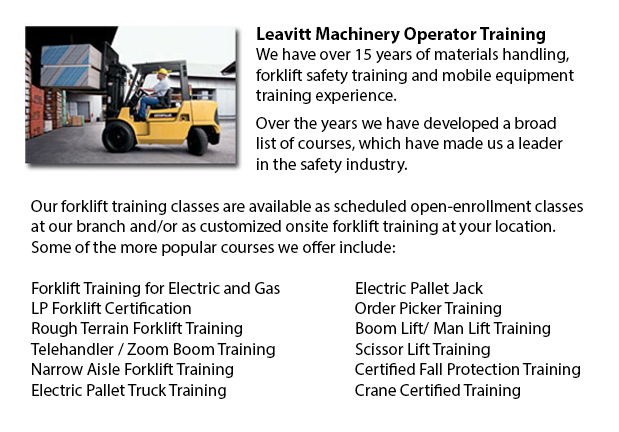
Forklift Training Schools Fort Mcmurray - Forklift Training Schools - For The Safety Of Your Workers
Are you searching for work as a forklift driver? Our regulatory-compliant mobile equipment operator training offers instruction in kinds of lift trucks, pre-shift inspection, fuel types and handling of fuels, and safe use of a lift truck. Practical, hands-on training assists participants in obtaining essential operational skills. Course content consists of existing regulations governing the utilization of lift trucks. Our proven forklift courses are meant to provide training on these kinds of trucks: narrow isle forklift, counterbalanced forklift and powered pallet truck.
Do not raise or lower the fork while the lift truck is traveling. A load should not extend over the backrest due to the possibility of the load sliding back toward the operator. Check for overhead obstacles and make sure there is enough clearance prior to lifting a load. Stay away from overhead power lines. When the load is lifted straight up, tilt it slightly back.
The lift truck is less steady if a load is in a raised position. Make certain that no body ever walks under the elevated fork. The operator must never leave the forklift when the load is lifted.
The forks should be level when handling pallets, and high enough to extend all the way into and underneath the load. The width of the forks must provide equal weight distribution.
Set the brakes and chock the wheels before unloading and loading the truck. The floors must be strong enough to support the weight of both the forklift and its load. Fixed jacks could be installed to support a semi-trailer that is not coupled to a tractor. The entrance door height should clear the height of the forklift by a minimum of 5 cm. Mark edges of docks, rail cars or ramps and avoid them.
-
Telehandler Training Fort Mcmurray
Telehandler Training Fort Mcmurray - Telehandlers or also called Telescopic handlers are very popular piece of heavy construction equipment most often utilized in agriculture and construction industries. These machines have extreme reaching capabilit... More -
Counterbalance Forklift Training Fort Mcmurray
Counterbalance Forklift Training Fort Mcmurray - Counterbalance Forklift Training courses are always in high demand. The Counterbalance forklift is a forklift that is made along with a weight that counters the balance, evenly spreading the weight of... More -
Heavy Equipment Training School Fort Mcmurray
Heavy Equipment Training School Fort Mcmurray - HEO or the heavy equipment operator courses will provide you with the knowledge and skills required in order to enter the workforce as an entry level heavy machine operator. In this 12 week course in ad... More -
Operator Safety Training, Re-Qualification Training, In-House Instructor Training in Fort McMurray
Used in just about all boat yards, industrial construction sites or warehouse operations, the forklift is a very important component in order to help pick up and transfer supplies. The reach feature of a lift truck could help improve the applications... More -
Heavy Equipment License Fort Mcmurray
Heavy Equipment License Fort Mcmurray - A heavy equipment license can be obtained by finishing a certification and preparation course at a private training school or a vocational school. This license would qualify you to operate various types of heav... More -
Boom Lift License Fort Mcmurray
Boom Lift License Fort Mcmurray - To operate an aerial boom lift, operators must be licensed through training that can be obtained utilizing both practical training and classroom sessions and by obtaining a boom lift license. Instruction must be give... More -
Skid Steer Loader Training in Fort McMurray
A skid-steer loader is actually an engine powered machine that consists of a small and rigid frame. It is outfitted along with lift arms which are used to attach to different labor saving attachments and tools. Normally, skid-steer loaders are four-w... More -
Order Picker Ticket Fort Mcmurray
Order Picker Ticket Fort Mcmurray - Order picker's enables warehouse employees to lift pallets using forks. Likewise called a stock picker, this electrically-powered equipment is like a forklift except that an order picker is likewise utilized to lif... More

Forklift Training Fort McMurray
TOLL FREE: 1-888-254-6157
Fort McMurray, Alberta
forklifttrainingfortmcmurray.com
Email Us
About Us


